Introduction
The town of Molong has a population of 2,515 (ABS, 2012) and is located 300 kilometres west of Sydney, NSW and 30 kilometres from the city of Orange, the principal centre for employment and services for the region. Historically, Molong has experienced flooding from the Molong Creek which runs near some residential areas and the central business district (CBD). Floods or threats of flooding (particularly leading to sandbagging preparations) have occurred most recently in 1995, 2005, 2010 and 2012 (Central Western Daily, 2010a; Central Western Daily, 2010b; Central Western Daily, 2012). In 2005, flooding caused damage to houses on the floodplain and to business premises in the CBD (ABC Rural, 2005). According to the NSW State Emergency Service (2007), the flood caused extensive damage to 30 buildings, eight people were rescued, 28 businesses were sandbagged, and the occupants of 12 houses were evacuated. The persistence of flooding and the ensuing damage in a relatively old and settled part of Australia is interesting because it suggests a failure to adequately prevent damage to people’s homes, assets and livelihoods despite improvement in floodplain risk management (Keys, 2006).
Background
For some time, the disaster management literature has explored the relative strengths and weaknesses of two divergent approaches. The first is what may generally be referred to as the ‘technocratic approach’ (Hewitt 1983), or more readily the ‘government-led’ approach. This encapsulates elements of bureaucracy and technology which signify assumptions of rationality and functionality in the foundations of the approach. This relates to their application in terms of structures, processes, systems, techniques and practices. These are generally housed within the institutions of the state, particularly government, military, police and, crucially, the state-based emergency service organisations which depend on volunteers drawn from the community. This remains the dominant approach despite the evidence that disasters in all their forms frequently overwhelm the institutions established to control them (Alexander 2002; Lindell, et al. 2007; Phillips, et al. 2010).
The second approach may be referred to as the ‘socially-constructed approach’. This concept seems to have emerged in large part to serve as an alternative to the ‘technocratic approach’. The basis is that risk is partially socially constructed rather than taken as given (Miller 2009, p.169) which opens the way for non-institutional approaches, particularly those involving the development of social capital within communities (Portes 1998). In general, social capital refers to the structures, processes and cultures that generate and maintain trust, co-operation and cohesion. This social capital can, in turn, be used by institutions and the community to improve risk management—a socially constructed, rather than a technocratic based, improvement (Hewitt 1983; Tierney 2007; Norris, et al. 2008). Some of the literature has developed these contested approaches (Quarantelli 1998) and applied them using different characteristics. For example ‘vulnerability’ versus ‘resilience’ (Phillips, et al. 2010, p.13) and a different way of thinking, for example, ‘…that resilience is a process that leads to adaptation, not an outcome, not stability’ (Norris et al. 2008, p.144).
Importantly for research purposes, Alexander (2002, pp.212-3) notes that the gap between the approaches means there is a question of the distribution and forms of control, particularly between state institutions and communities. In short, much of the literature has understandably relied on a spectrum of theoretical approaches that have ‘a technological approach’ at one end and ‘a socially-constructed approach’ at the other. The task is to examine and draw useful conclusions in terms of how these are blended. The case study data revealed that the reality for Molong was somewhere between the extremities of the technological approach and the socially-constructed approach. Social capital encompasses relationships and wider networks at one extreme, and institutions, which are primarily state-funded and/or controlled in whole or with permanent managerial functions overlaying a volunteer base, at the other. Thus it is possible to view the institutional and social approaches to disaster management as two extremes of a continuum. Any given disaster situation will exhibit a mixture of both institutional and social responses and can be represented by a point on this continuum.

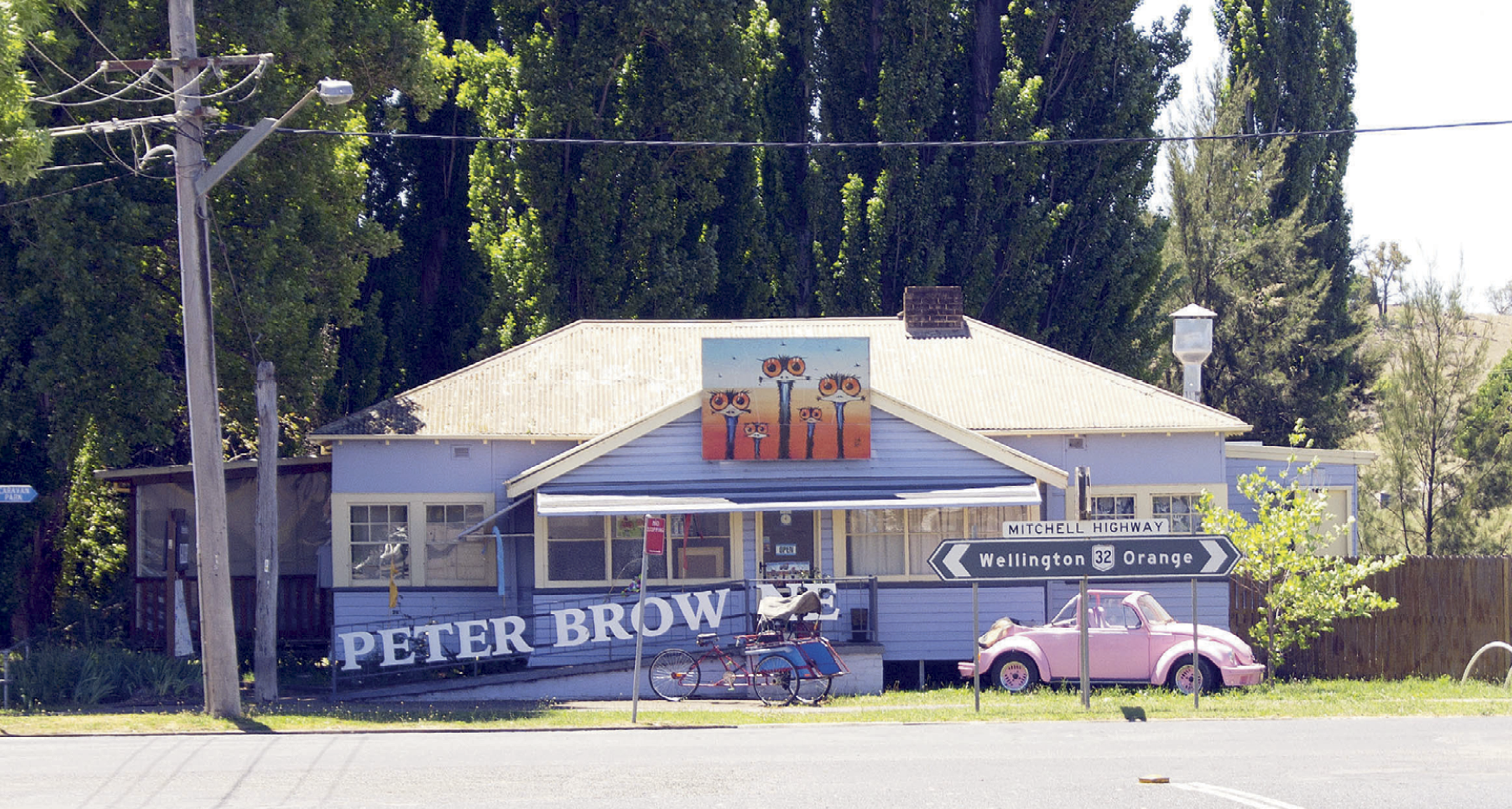
Images: Ian Manock
Flood waters reached the front door sill of the gallery at the intersection of Gidley Street and Mitchell Highway.
This broad spectrum of approaches has become integrated into emergency management in Australia. There has been a growth in attempts to analyse and promote different approaches which fall between the extremities of the theoretical spectrum which rest on the notion of resilience. Some of the literature emphasises the role of policy at both state and local government levels, particularly the implication that planned development incorporates flood mitigation within an established institutional context and that such an approach is critical to community resilience (Thomas, et al. 2011, p.15). On the other hand, the notion of resilience is associated with the role of communities themselves, in part at least, assuming a greater role for social capital. However, some of the literature has moved towards integrating institutional approaches from within state and community involvement at one or more phases of flooding as a process (e.g. Cottrell, 2005; Gissing, et al. 2010), and in relation to bushfire preparedness (Frandsen, et al. 2012). Moving in this direction makes assumptions about the blending of social capital and institutions depending on the precision of the concept of resilience as an explanatory tool and as a basis for practical methods of dealing with emergencies. Gissing, et al. (2010, p.44) provide a guide to this direction, crucially identifying the need for ‘cultural change within the emergency management agencies’ and ‘further engagement … to ensure stronger partnerships … between agencies and the community’.
The relationship between the two approaches to disaster management is explored. In particular, the relationship between established political and disaster management institutions and institutional arrangements, and the espoused attitudes of the community and the social capital which underpins and/or arises out of these attitudes. The purpose is to identify differences and similarities in terms of the two approaches and to identify the elements of each which leads to enhanced resilience. This is in the context of the four-phase (prevention, preparation, response and recovery) approach to flood management as found in the literature.
Research methods
The research was conducted in early 2012. Background material on the town and the town’s history of flooding was obtained. Prime source data was gathered in two stages with the assistance of the regional SES. First, a postal survey of 772 households was conducted which generated a response rate of 7.3 per cent (57 useable responses). Subsequently a follow-up town meeting was held to which all residents were invited. The mayor, several councillors, staff from the local SES, a number of local business leaders, and 26 residents attended the meeting. Attendees were asked a series of questions designed to refine and deepen the survey data. It was at this meeting that a clearer understanding of the reasons behind the small survey response rate was presented by community members attending.
The survey was constructed in terms of the three-phase approach to flood management. It included questions about specific dimensions of Molong flooding. The survey allowed participants to respond in a prioritised order of preference in some questions, i.e. tick more than one box. Unfortunately, the low response rate to the survey precluded advanced statistical analysis beyond basic descriptive results. Therefore, the findings and the conclusions drawn from the survey must be interpreted as indicative rather than conclusive. When examined in association with responses from the community meeting, a clearer picture of the town’s preparedness and issues relating to the flooding hazard and the psychosocial impact on residents emerged.
Research findings and analysis
Preparedness
Respondent perception of their preparedness for flooding was relatively high. Figure 1 shows that 80 per cent said they assessed they were prepared ‘moderately’ (29.4 per cent), ‘well’ (27.5 per cent), and ‘totally’ (23.5 per cent). In addition, a large majority stated they had insurance cover of home (86.5 per cent), contents (80.8 per cent), and vehicle (65.4 per cent).
Figure 1. Self-reported preparedness in Molong in 2012 (Percentages)*.

Emergency warnings take two broad forms:
- informal and largely individual, and
- official public.
The highest informal warning response (first choice) was weather reports (42.3 per cent) followed by rising river levels (13.5 per cent). The highest public warning sources (first choice) were SES personnel doorknock (30 per cent), radio (26 per cent), television (20 per cent), SMS (2 per cent), and email (2 per cent).
Figure 2 illustrates the respondents’ preferred method of receiving a warning. This was by SES personnel doorknock (43.1 per cent). For the preparedness phase, warning systems continue to be critical. Whether by general weather reports or specific warnings, the systems most reported as being relied on in Molong are those emanating from institutions.
Figure 2. First choice of public warning systems in Molong in 2012 (Percentages)*.
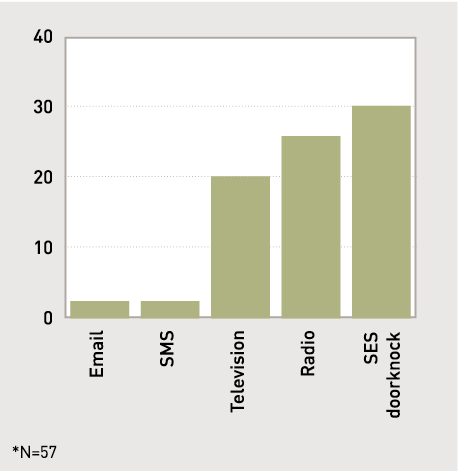
Response
In terms of response, the survey compared an expectation of who would help and the reality of who did help. The ‘most likely’ expectation (see Figure 3) was the SES (44.2 per cent) followed by family and local government (each 17.3 per cent). Neighbours constituted 1.9 per cent.
Figure 3. Most likely expectation of help source in Molong in 2012 (Percentages)*.
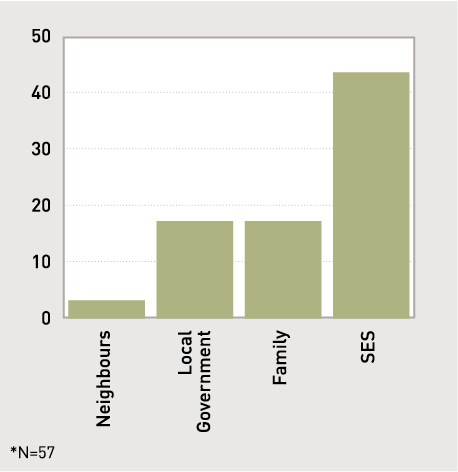
In terms of the ‘second most likely’ expectation, state government and the fire brigade were each 7.7 per cent, community organisations were 5.8 per cent, and friends were 1.9 per cent. In short, the expectation was primarily a perception that institutions would play the most significant role in assistance.
Figure 4 shows the multiple answers to the response phase question ‘…who did help…’. Results suggest a more extensive role for the community, particularly neighbours (64.7 per cent), friends (58.5 per cent), and family (41.2 per cent). However, the role played by institutions (see Figure 5) was also significant with SES (64.7 per cent), community organisations (38.2 per cent), local government (35.3 per cent), and local business (26.5 per cent).
Figure 4. Who did help in the response phase in Molong in 2012 (Percentages)*.
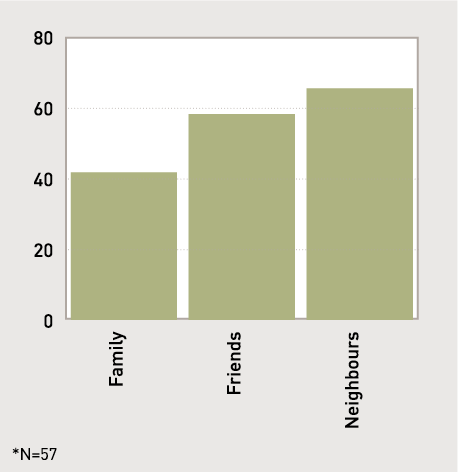
Figure 5. Which institutions provided help in the response phase in Molong in 2012 (Percentages)*.

The findings indicate a discrepancy between expectation and reality. Interestingly, the role of people in the community is undervalued whereas the role of the key emergency institution (the SES) is valued relatively highly in terms of both expectation and reality.
Recovery
In response to the question about recovery, 52.1 per cent of respondents said they recovered ‘well’ or ‘completely’ compared to 47.9 per cent who said that they ‘did not recover’ or ‘just’ recovered. Responses at the town meeting supported this finding and also identified that there were some divisions, particularly economic or financial, between community members who recovered from the flooding and those who experienced continuing problems resulting from the flooding. In terms of the expectation of recovery costs (see Figure 6), respondents stated they relied on family and friends (32.4 per cent), state government (21.6 per cent), Federal government (10.8 per cent), community appeals (8.1 per cent), local government and community organisations (5.4 per cent each), and businesses (2.7 per cent). Clearly, in terms of the expectation as to who would assist them financially, people valued family and friends before institutions. In terms of the most beneficial source of recovery information, respondents rated local government (39.1 per cent) and the SES (21.7 per cent) as the two most important sources. The other three main categories were the Federal government, businesses, and family and friends (each 6.5 per cent). Thus, while community members relied more on family and friends to assist with the recovery costs, the local government and SES were the greater source of recovery information.
Figure 6. Expectation of reliance of recovery cost in Molong in 2012 (Percentages)*.

The survey attempted to assess the strength of the community in several ways. An assessment of a ‘sense of community’ was explored with a majority of respondents stating that it had improved over time (52 per cent) with 36 per cent stating that it had ‘remained the same’ and 4 per cent stating that it had ‘deteriorated a lot’.
In terms of levels of ‘co-operation and help’, 29.5 per cent stated they had experienced this to a ‘very great degree’, 27.3 per cent to ‘a degree’, 25 per cent to a ‘large degree’, 9.1 per cent to a ‘very little degree’, and 9.1 per cent ‘not experienced at all’. Only moderate response rates were found in terms of ‘making new friends’, ‘bringing family closer together’ and ‘increased involvement in the community’. The results suggest that social capital is improving, providing greater resources for a socially-constructed outcome.
The perceived psychological impact of flooding was also assessed by asking whether respondents felt helpless, vulnerable and despair in the aftermath of the flooding. Around 54 per cent of respondents reported no such experience of psychological distress. However, 45 per cent of respondents did report psychological distress at various levels. Among the respondents who reported that they experienced some level of distress, 33 per cent (14.9 per cent of all respondents) asserted that the level of the distress was large to a great degree. While 66 per cent did not have any sense of abandonment or isolation in the aftermath of the flood, 14.6 per cent did report that they experienced a large to a great degree of such emotional upset. The findings indicate that the SES and government organisations need to incorporate an effective mental health support system and psychological recovery framework in their preparedness program for this flood-prone regional country town (see IASC, 2007).
Prevention and mitigation
Almost all respondents, 55 out of 57, responded to the question ‘What do you believe should happen to improve future flood management in Molong?’. Almost all respondents identified maintenance of Molong Creek through clearing debris and improved design and construction of drainage systems to prevent the damming of floodwater so that water can flow away faster. A few respondents mentioned an improved building permission and buyback system for buildings on the floodplain. In other words, the experience of those who answered this question related to technical preventative and/or mitigating solutions to the problem.
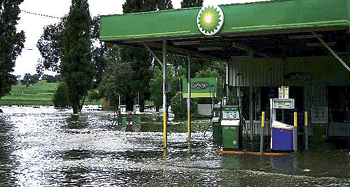
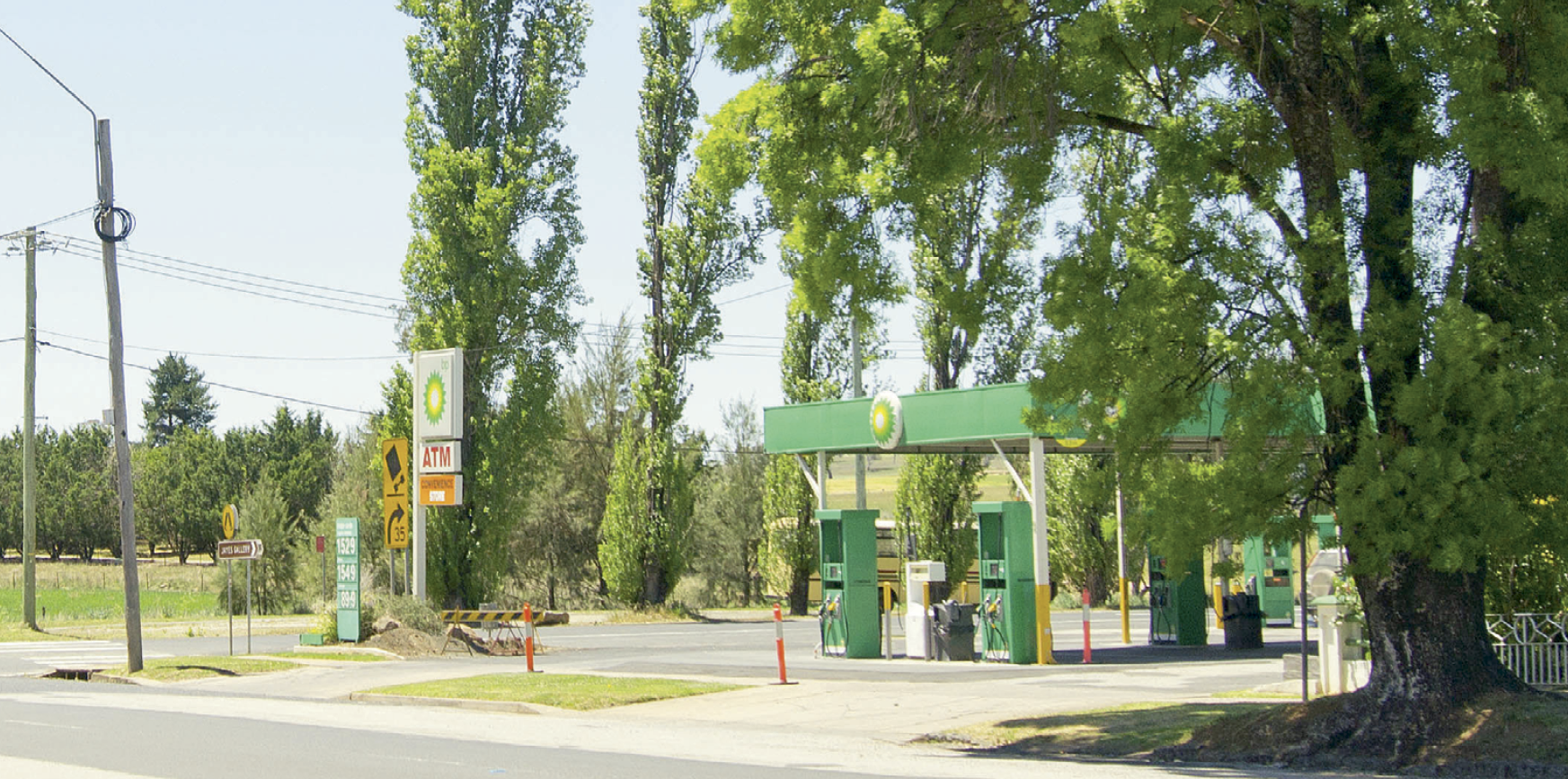
Images: Ian Manock
At the intersection of Gidley Street and Mitchell Highway floodwaters lapped the bottom of the petrol pumps at the BP Service Station.
The repetitive nature of flooding indicates that the town is vulnerable to loss of, or damage to, residences and businesses. This has the consequence of perceived depreciation of property and inventory values. Consequentially there was a stifling effect on the potential of the town to develop and sustain economic growth, in some part due to the impact of flooding on the businesses within the town’s CBD. One attendee at the community meeting stated “the business centre here, has never recovered. Never recovered since 2005. Um...as a matter of fact any business that’s here and still operative...they’re all hanging. Just hanging.” While this can be the result of a number of factors–including general economic conditions and/or drought–the respondent clearly attributed it to the flooding since 2005.
Given the history of flooding, it seems reasonable to conclude that for whatever reasons (probably those involving public funding of preventive infrastructure by governments and the resilience of the population to recover) improvement is likely to be slow and intermittent. Possible solutions include governments buying houses in the most vulnerable parts of the town. At the time of the research there was no indication that government, at any level, was addressing the problem in terms of a significant solution. The community identified that the most desirable mitigation option was a series of technical changes to preventing water from entering the most vulnerable parts of the town, including the CBD. This has not materialised. At the meeting it was identified that the local government had stated that the construction of a levy system on the Molong Creek was too expensive.
At the community meeting, one resident said 200 people had attended a meeting after the 2005 flood, but far fewer people attended the meeting arranged for this study. One member of the Molong flood mitigation committee stated, “The saddest thing coming in here tonight is the number of people here. This place should be packed, but the reason it’s not packed is because everybody knows that nothing is being done. After all the trouble we’ve been going through for the last 15 years to get something done....and expenditure in water reports and feasibility studies...and it’s all come to the fact that nothing can be done.” The community simply feels powerless to influence the management of the flooding hazard to the town. The SES regional staff had endeavoured to improve the warning regime through earlier doorknocking and issuing specific community bulletins through the media. It was clear from the survey responses and the meeting that the volunteer organisations (SES and Bush Fire Brigade) were praised for their past work and valued through all phases of flooding.
It is possible to argue that social capital is an integral part of community organisations and business and that community organisations and businesses have a role to play in building up social capital. The results suggest that, in terms of assistance during flooding and recovery phases, friends, neighbours and family were important. In other words, the non-institutional forms from which social capital is drawn, remains a clear element of the town’s response to flooding. It is interesting that the elements of social capital (structures, processes and cultures that generate and maintain trust, co-operation and cohesion) were not specifically identified as a key source of surviving the flooding, nor extensively discussed in terms of value and/or criticism. Nevertheless, it did emerge in various forms. For example, one resident at the meeting mentioned the local newsagent proprietor whose building was destroyed, and that ‘…the morning after the flood he had a table on the front and was selling newspapers. And I thought that was the greatest thing he could have done because it gave us some familiar part of our lives…’. By contrast, some institutions, particularly governments as opposed to the volunteer organisations, were extensively criticised primarily on the basis that they did not perform the role that the respondents expected them to perform. This blaming is common after the impact of hazardous events and can be expected from a public forum. As Holmes (2010, p.389) points out, “Looking for someone to blame might satisfy our base desires but will it really help us next time around?”. For example residents were critical of the NSW Department of Primary Industry Office of Water for not doing more to undertake upstream mitigation activities on the Molong Creek which was regarded as a way to reduce the impact of flooding in Molong.

Image: Ian Manock
Molong Railway Bridge showing estimated flood height on the electrical box.
Conclusion
The most significant finding of this case study is the perception that the established institutional framework at large, but specific organisations such as the SES, local and state governments and community organisations, would play the most significant roles throughout most phases of flooding. This is despite the fact that community members, families and friends were those who provided support. Institutions provided information and some financial relief. It is reasonable to draw the conclusion that the people who responded to the research questions in the survey and attended the meeting were viewing the problem and solutions to it through a technological lens. Most significant was the related and consistent value placed on institutions. In doing so, this supported and perhaps entrenched a belief which constituted dependency on those institutions. The fact that the town continues to be vulnerable to flooding and there is no guarantee of significant improvement in institutional responses, the only logical conclusion is that Molong will be at risk of flooding and the community will suffer the physical, psychological, environmental and economic consequences that flooding causes. Unless there is a change in the perceived attitudes of both institutions and the community, little can be done to build community resilience to inevitable flooding events.
References
ABC Rural, 2005, Molong Assesses Flood Damage, 8/11/2005, www.abc.net.au/rural/content/2005/s1500367.htm. Accessed 30 May 2012.
Alexander, D. 2002. “From Civil Defence to Civil Protection – and Back Again.” Disaster Prevention and Management 11: 209-13.
Australian Bureau of Statistics (ABS) 2011 Census QuickStats, 27/11/2012 www.censusdata.abs.gov.au/census_services/getproduct/census/2011/quickstat/SSC11572?opendocument&navpos=220. Accessed 27 November 2012
Central Western Daily, 2010a, Molong Floods, 12/8/2010, www.centralwesterndaily.com.au/news/local/news/general/molong-floods/1911297.aspx. Accessed 30 May 2012
Central Western Daily, 2010b, Molong Being Sandbagged, 9/12/2010, www.centralwesterndaily.com.au/news/local/news/general/molong-being-sandbagged/2021636/aspx. Accessed 30 May 2012.
Central Western Daily, 2012, Flood Watch Issued for Orange and Molong, 27/2/2012, www.centralwesterndaily.com.au/news/local/news/general/flood-watch-issued-for-orange-and-molong/269086.aspx. Accessed 30 May 2012.
Coles, E. and Buckle, P., 2004, Developing Community Resilience as a Foundation for Effective Disaster Recovery, The Australian Journal of Emergency Management, Vol. 19, No. 4, p.615.
Cottrell, A., 2005, Sometimes it’s a Big Ask, but Sometimes it’s a Big Outcome: Community Participation in Flood Mitigation, Australian Journal of Emergency Management, Vol. 20, No. 3, pp.27-32.
Frandsen, M., Paton, D. and Sakariassen, K., 2012, Fostering Community Bushfire Preparedness through Engagement and Empowerment, Australian Journal of Emergency Management, Vol. 26, No. 2, pp.23-30.
Gissing, A., Keys, C. and Opper, S., 2010, Towards Resilience Against Flood Risks, The Australian Journal of Emergency Management, Vol. 25, No. 2, pp.39-45.
Hewitt, K. (ed.), 1983, Interpretations of calamity: from the viewpoint of human ecology, Allen and Unwin, Boston.
Holmes, A., 2010, A reflection on the Bushfire Royal Commission – Blame, accountability and responsibility, Australian Journal of Public Administration, Vol. 69, No. 4, pp.387-391.
IASC Guidelines on Mental Health and Psychosocial Support in Emergency Settings, 2007. www.humanitarianinfo.org/iasc. Accessed 18 September, 2012.
Keys, C., 2006, The Evolution of Floodplain Risk Management and Real-time Flood Management in New South Wales, The Australian Journal of Emergency Management, Vol. 21, No. 1, pp.3-8.
Lindell, M. K., C. Prater and R. W. Perry. 2007. Introduction to Emergency Management Hoboken, New Jersey: John Wiley and Sons.
Miller, K. D. (2009). Organizational risk after modernism. Organization Studies, Vol. 30(02-03), pp.157-180.
Norris, F. H., Stevens, S. P., Pfefferbaum, B., Wyche, K. F. and Pfefferbaum, R. L. 2008, Community resilience as a metaphor, theory, set of capacities and strategy for disaster readiness, American Journal of Community Psychology, Vol. 41, pp.127-50.
Phillips, D. B., Thomas, D. S. K., Fothergill, A. and Blinn-Pike, L. (eds.), 2010, Social vulnerability to disasters, Taylor and Francis, Baton Rouge, Florida.
Portes, A. 1998, Social Capital: its Origins and Applications in Modern Sociology, Annual Review of Sociology Vol. 24, pp.1-24.
Quarantelli, E. L. (ed.), 1998, What is a disaster? Perspectives on the question, Routledge, London
State Emergency Service (SES), 2007, New Molong FloodSafe Guide Launched, www.ses.nsw.gov.au/news/archive-2007/new-molong-floodsafe-guide-launched. Accessed 30 May, 2012.
Tierney, K. J., 2007, From the margins to the mainstream? Disaster research at the crossroads, Annual Review of Sociology, Vol. 33, pp.503-525.
Thomas, M., King, D., Keogh, D. U., Apan, A. and Mushtaq, S., 2011, Resilience to Climate Change Impacts: A Review of Flood Mitigation Policy in Queensland, Australia, Australian Journal of Emergency Management, Vol. 26, No. 1, pp.8-17.
About the authors
Ian Manock, Dr Rabiul Islam, Prof John Hicks, Dr Richard B. Sappey and Dr Valerie Ingham are members of the Bangladesh Australia Disaster Research Group Charles Sturt University. They research community expectations and experiences of emergency management, risk perception and social capital and aim to develop a multi-disciplinary and cross-cultural model which will strengthen community resilience.


